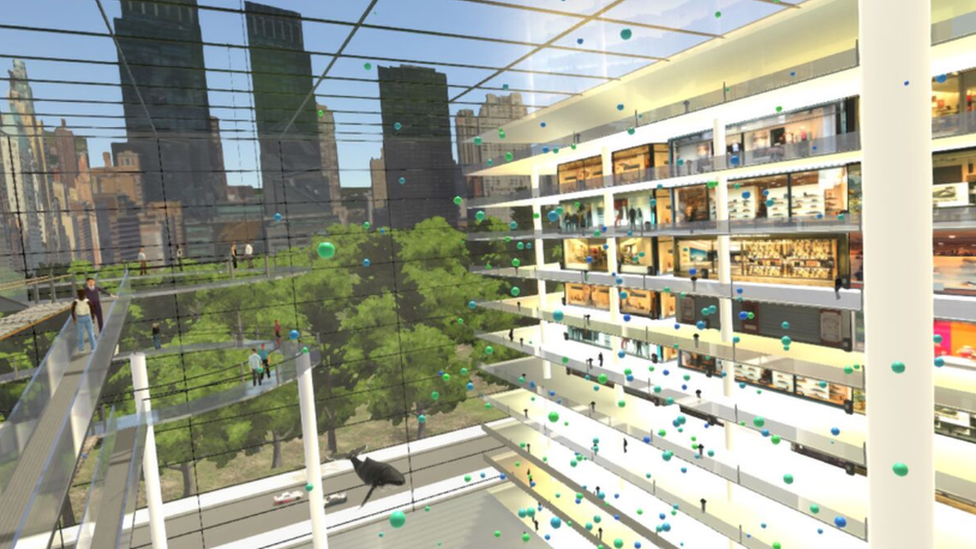'Virtual reality cured my fear of heights'
- Published

Fay celebrating her achievement at a rooftop bar
Fay Nugent developed a fear of heights in her 30s.
"It began after I went on a girls' weekend away," she says.
"We had gone on an adventure activity called a tree-top walk.
"I managed to climb up to do it - but then when it came to stepping out on to the high ropes, I just couldn't do it.
"I felt physically ill and panicked, even though I knew I was perfectly safe."
Her phobia got worse over the next few years, to the point that it stopped her doing everyday things.
"I went to a concert at Wembley to see Take That," she says.
"It's a massive venue and our seats were at the back, high up.
"I tried to go up there to take my seat - but all of a sudden I had this feeling of utter panic.
"It was a bit like in the cartoons when the character's eyeballs go out on strings."
Acrophobia
Fay, now 48, started avoiding fearful situations, which, for her, included riding escalators.
"It was the downward ones that worried me the most," she says.
"It wasn't so much that I was worried about tripping, I was scared of being up high and the sensation of getting pulled downwards."
Then, Fay, who works in malaria research at Oxford University, heard about a phobia therapy trial taking place in a different part of the institution.
She applied and was invited to join in. But, unfortunately, she was placed in the control group rather than the treatment one that would try out the new innovation - a virtual reality (VR) program for acrophobia (the medical term for a fear of heights).
A volunteer using the VR simulator
Most of the people in the trial had been scared of heights for 30 years or more.
The ones in the treatment group - 44 in all - were given five or six 30-minute sessions of the VR treatment over the course of two weeks.
The results, which are being published by The Lancet Psychiatry, external, were significant. About 70% of the VR group no longer had a fear of heights, while, unsurprisingly, all of the people in the control group, who received no treatment, still did.
Fay has now had the same therapy herself.
"Once the trial was finished, they offered it to me and I am so pleased that I said yes," she says.
"Heights don't worry me now. I recently managed to get on a 30m-long [100ft] escalator at Helsinki airport and I was absolutely fine."
The VR simulator immerses people in a safe situation where they can learn to manage their fear.
The user wears a VR headset and is asked to work their way up a 10-storey building and complete fear-inducing tasks, such as looking down over a high ledge and throwing balls off it.
One of the hardest ones is walking out on to a platform to rescue a cat stuck in a tree or riding around the building's atrium on the nose of a giant whale called Wilber.

Lead researcher Prof Daniel Freeman said: "We wanted tasks that would be fun and engaging and most importantly make the person look down to face their fear.
"It had to be something that would teach them to feel safe with heights."
The therapy is also delivered by a virtual coach who reassures and guides the user along the way.
Prof Freeman said some patients might prefer this to face-to-face therapy with a clinician. Ultimately, it might also save the NHS money.
"We need a greater number of skilled therapists, not fewer," he said, "but to meet the large demand for mental health treatment, we also require powerful technological solutions.
"We are about to start a pilot of this VR therapy with some NHS clinics. Hopefully, it will be a useful new way to help people overcome their fears."
A fear of heights is the most common phobia - one in five people has it at some point.
The study was funded by Oxford VR - a spin-out company of Oxford University - and the National Institute of Health Research Oxford Health Biomedical Research Centre.
- Published28 January 2017
